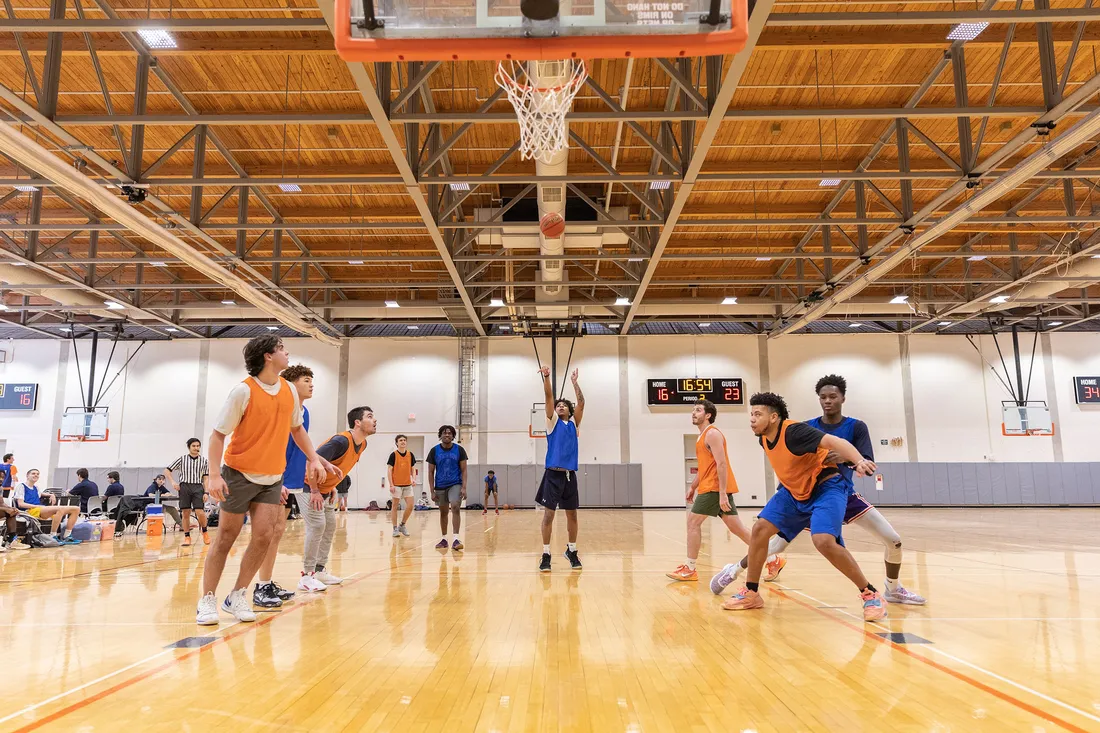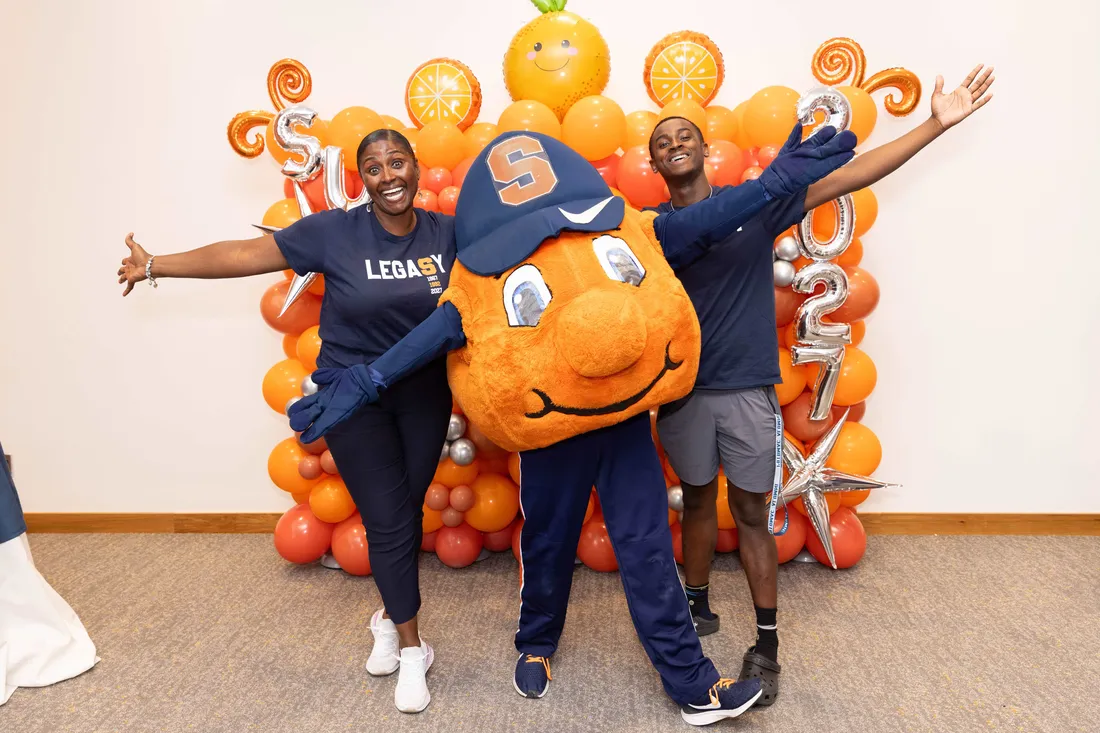
The 1923 Syracuse University football team posted an 8-1 record, with seven shutouts. Courtesy of University Archives, Special Collections Research Center, Syracuse University Libraries.
When the Syracuse University football team meets the University of Pittsburgh in Yankee Stadium on Nov. 11, the clash between the longtime rivals will mark the 100th anniversary of when they played the first collegiate football game at the original Yankee Stadium.
The Orange hammered out a 3-0 victory over the Panthers on Oct. 20, 1923, before a crowd of 25,000. This year’s game marks the 79th meeting between the two Atlantic Coast Conference teams, which have played every season since 1955. They’d first squared off on the gridiron in 1916. In 1923, Syracuse was seeking its first victory over Pitt since 1919, and the Orange squad was formidable: It entered the game undefeated (3-0), outscoring opponents 117-3, en route to an 8-1 season highlighted by seven shutouts.
Here’s a look at how that game unfolded a century ago:
Welcome to the ‘New’ Yankee Stadium
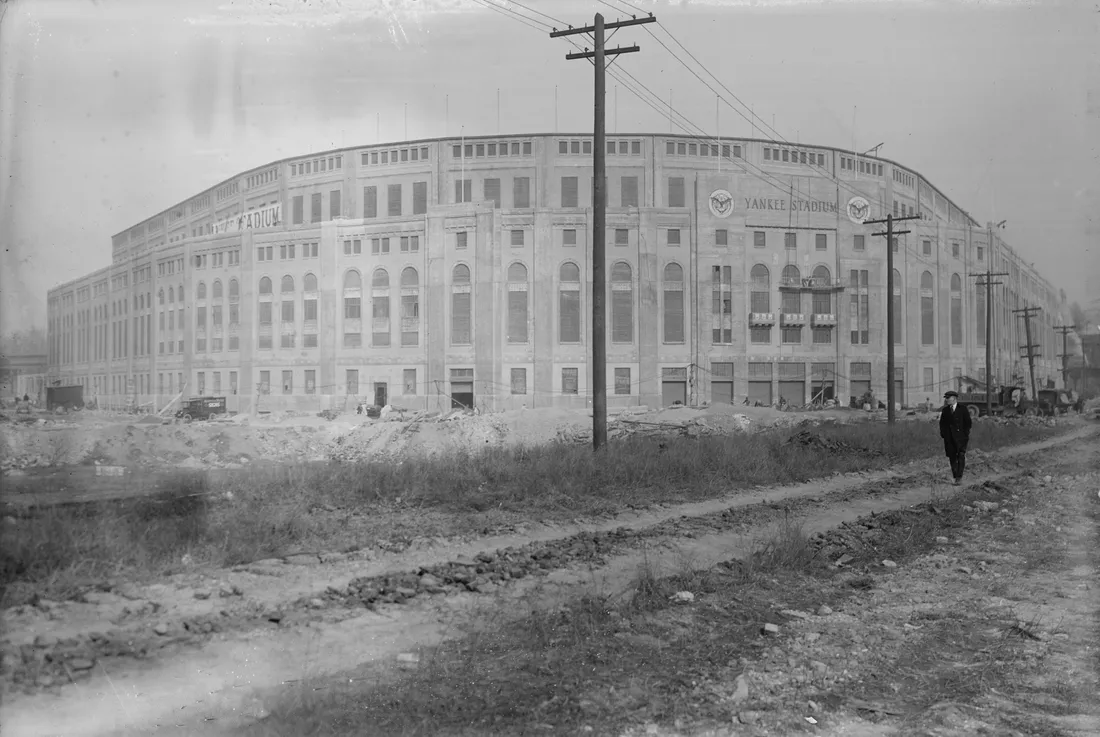
Yankee Stadium took 11 months to build, making it the largest and most costly ($2.5 million) baseball park of the time when it opened in 1923.
The grand stadium in the Bronx officially welcomed fans on April 18, 1923. But baseball wasn’t the only sport scheduled for the new $2.5 million stadium: Nine college football games were lined up for fall 1923.
World Series Shuffles Football Schedule
The Babe Ruth-led Yankees and New York Giants advanced to the 1923 World Series. The games were played at Yankee Stadium and the Polo Grounds, Oct. 10-15, with the Bronx Bombers emerging over their cross-town rivals, 4-2 in the series, capturing their first World Series title. With the ballparks in use, the Army-Notre Dame football game set to kick off at Yankee Stadium on Oct. 13 was moved to Ebbets Field, home of the Brooklyn Dodgers.
Orange and Panthers Move to Front of the Line
The Syracuse and Pittsburgh showdown was next on the schedule for Yankee Stadium and, with the World Series over, the teams from the Salt City and the Steel City met in the Bronx, collecting the honor of being the first collegiate gridiron game in the House That Ruth Built.
Dominating Defense and Tickets in Demand

The game program cover featured Syracuse All-American and Captain Evander “Pete” MacRae.
In a game preview, The New York Times lauded Syracuse, noting that the Orange’s goal line had not been crossed and they’d only yielded a field goal so far. “When the two teams clash tomorrow afternoon at 2 o’clock Syracuse will present what is hailed as one of the strongest Orange elevens [teams] in many years.” The article also reported a “huge demand for tickets,” noting “Officials of the big concrete stadium, just finished with handling world’s series [sic] crowds that broke all attendance records, say they are ready to take care of any number of fans.”
‘Orange Special’ Train Heads for the Big Apple
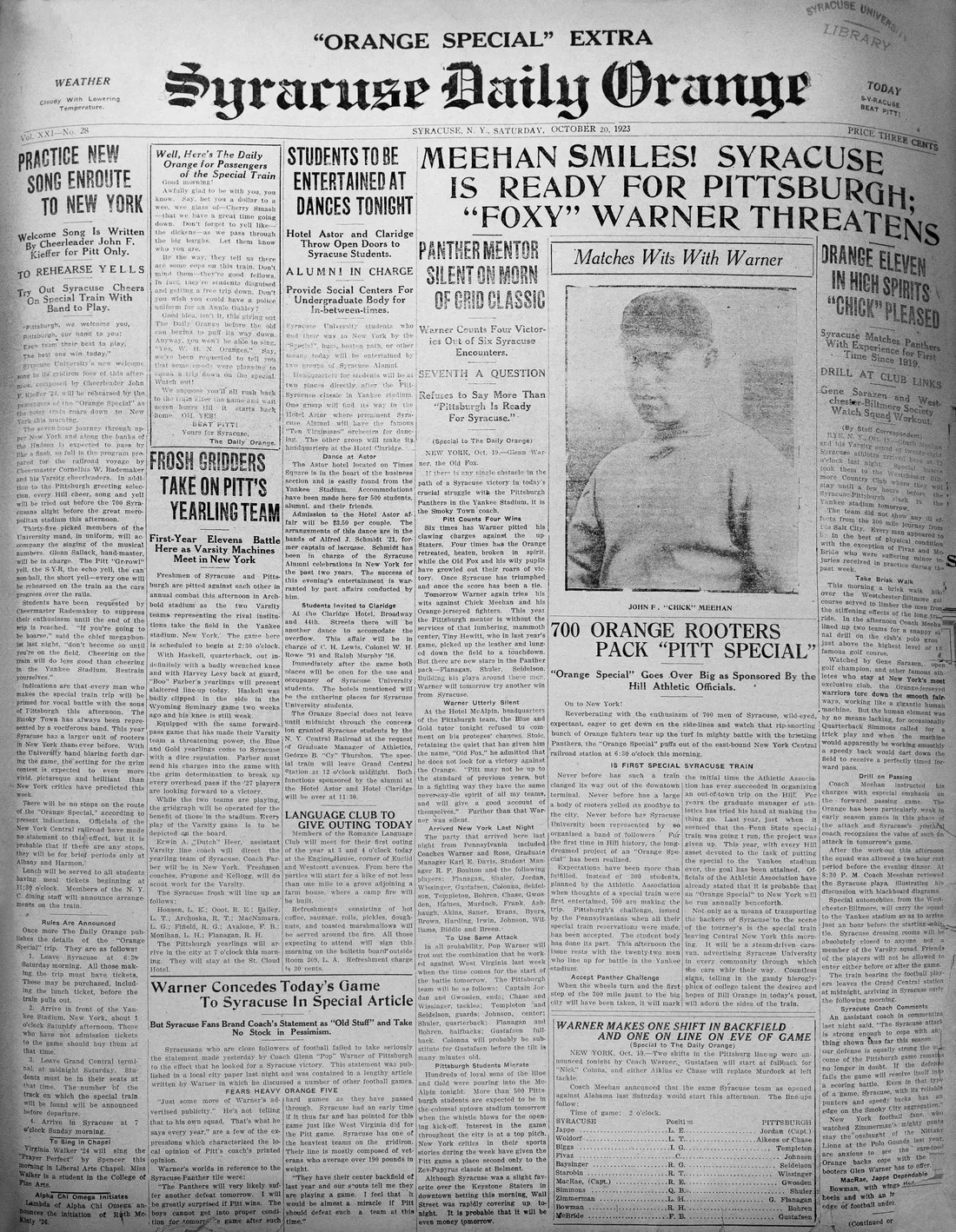
The Syracuse Daily Orange created a special edition for the Yankee Stadium showdown with the Pitt Panthers. Courtesy of University Archives, Special Collections Research Center, Syracuse University Libraries.
On game day, the Syracuse Daily Orange (DO) published the “Orange Special” Extra, with the front page chock full of game details and exuding excitement that the Athletic Association was sending a train full of students to a football game for the first time. “Reverberating with the enthusiasm of 700 men of Syracuse, wild-eyed, expectant, eager to get down on the sidelines and watch that rip-snorting bunch of Orange fighters tear up the turf in mighty battle with the bristling Panthers, the ‘Orange Special’ puffs out of the east-bound New York Central railroad station at 6:30 o’clock this morning,” one article reads. “Never before has such a train clanged its way out of the downtown terminal… For the first time in Hill history, the long-dreamed project of an ‘Orange Special’ has been realized.”
A Clash of Titan Coaches

Pitt coach Glenn “Pop” Warner played college football at Cornell, where he gained his nickname, and became one of the sport’s most revered innovators.
Pitt was led by a coach whose name became synonymous with football: Glenn “Pop” Warner, who’d notched three national championships (1915, ’16, ’18) with the Panthers. But 1923 would prove to be his worst—and last—season at Pitt, moving on the following season to Stanford.
The DO referred to Warner as the “Old Fox,” reporting that “If there is any single obstacle in the path of a Syracuse victory in today’s crucial struggle with the Pittsburgh Panthers at Yankee Stadium, it is the Smoky Town coach.” But Warner had his reservations about the game, saying “Pitt may not be up to the standard of previous years, but in a fighting way they have the same never-say-die spirit of all my teams, and will give a good account of themselves.”

Syracuse coach John “Chick” Meehan led the Orange to 35 victories in his four seasons on the Hill. Courtesy of University Archives, Special Collections Research Center, Syracuse University Libraries.
Guiding Syracuse was John “Chick” Meehan, a former star quarterback for the Orange (1915-17) who had returned to the Hill in 1920 to coach following service in the Navy during World War I. The 1923 squad would register the first of two straight eight-win seasons for Meehan, who’d then depart to coach New York University.
Orange Quarterback Would Become Known for More Than Football
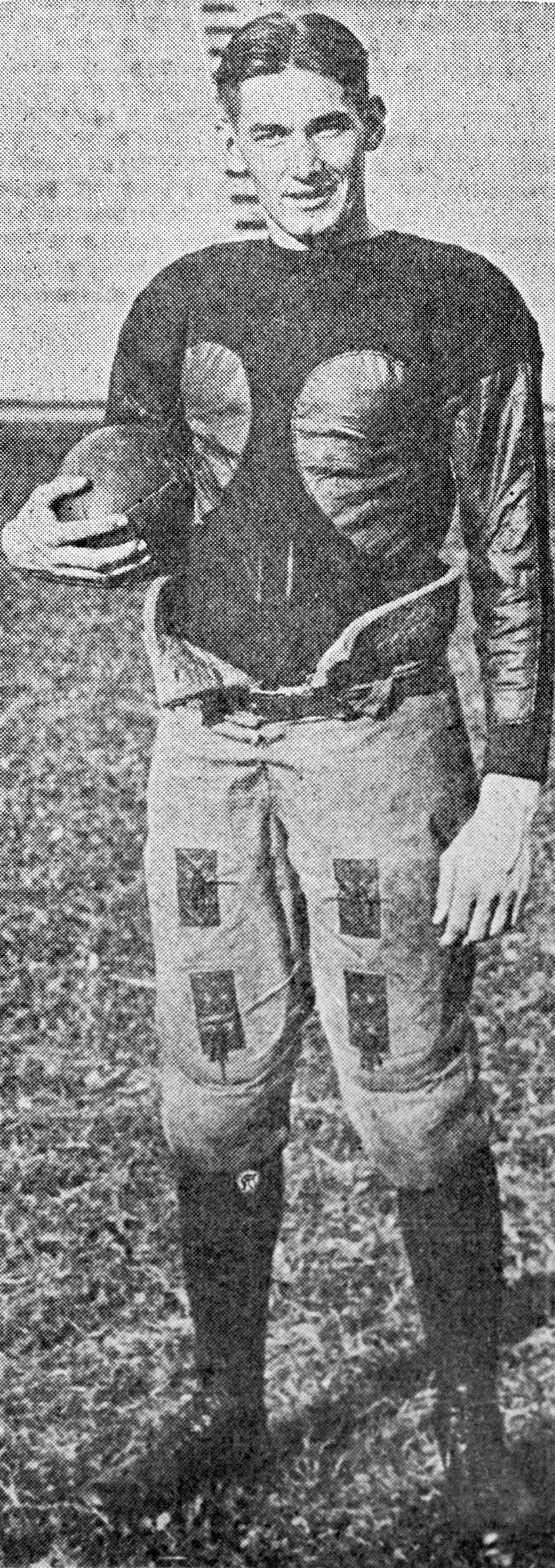
Roy Simmons Sr. was a superb student-athlete who went on to a distinguished coaching career. Courtesy of University Archives, Special Collections Research Center, Syracuse University Libraries.
Syracuse’s signal caller was Orange legend Roy Simmons Sr. A versatile and talented athlete, Simmons was a three-time letterman in football, earned All-America honors playing on two national championship lacrosse teams and would become a Hall of Fame lacrosse coach, leading the Orange from 1931 to 1970. He also guided the boxing team to a national title in 1936 and served as an assistant coach on the 1959 national champion football team. “Simmons, Coach Meehan’s field general, is showing a knowledge of the gridiron game well nigh equal to the football sense of many coaches,” the DO reported. “Not only can the redoubtable Simmons handle an eleven like a Roman captain, but he can carry a football towards a Pittsburgh goal just as surely as Jack Dempsey is the hardest hitting slugger in the world’s heavyweight ring.”
Two other stars on the 1923 squad—Captain and All-America end Evander “Pete” MacRae and Reaves “Ribs” Baysinger—also later coached at Syracuse. MacRae worked as an assistant basketball coach, and Baysinger led the Orange football team in 1947 and 1948.
A Third-Quarter Field Goal Puts the Orange on Top
The Orange and Panthers battled through a scoreless first half, with Pitt stopping one Orange drive a foot short of the goal line. But Syracuse’s ground game pounded away at Warner’s defense, and in the third quarter the Orange capitalized on a fortunate break. Pitt blocked a field goal attempt by the Orange’s John McBride, but the football rebounded off the defender and McBride grabbed it. Syracuse advanced again. Then, from Pitt's 25-yard line, according to the Norwich (N.Y.) Sun, “McBride gathered in his loam, set up his tee, cleaned his cleats. Again the lines met, but this time the Meehan line held. McBride got the kick away for three points.”
Post-Game Revelry But Don’t Miss the Train
According to the DO, alumni hosted post-game dances for Syracuse students at the Hotel Astor in Times Square, featuring the music of “the famous” Ten Virginians, and the Claridge Hotel at Broadway and 44th, with the “Orange Special” not scheduled to depart Grand Central until midnight.
By day’s end, football and festivities proved to be a winning combination for Orange Nation. “It was a colorful crowd which assembled at the Yankee Stadium to witness the opening of the football season in the New York baseball parks,” The New York Times reported. “Vivid colors were seen everywhere as the bunting of each team was waved in excitement.”

